

Matt Campbell
2026 Hyundai Tucson Hybrid review
8 Hours Ago
2021 brings a key safety update to the cheap-and-cheerful Rio Sport, making it even more worthy of consideration for your 'first car'.
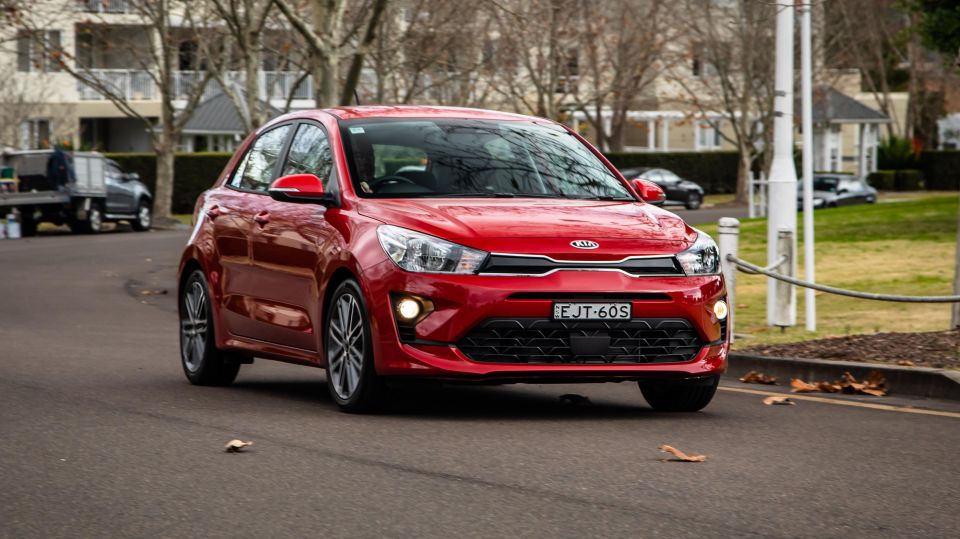
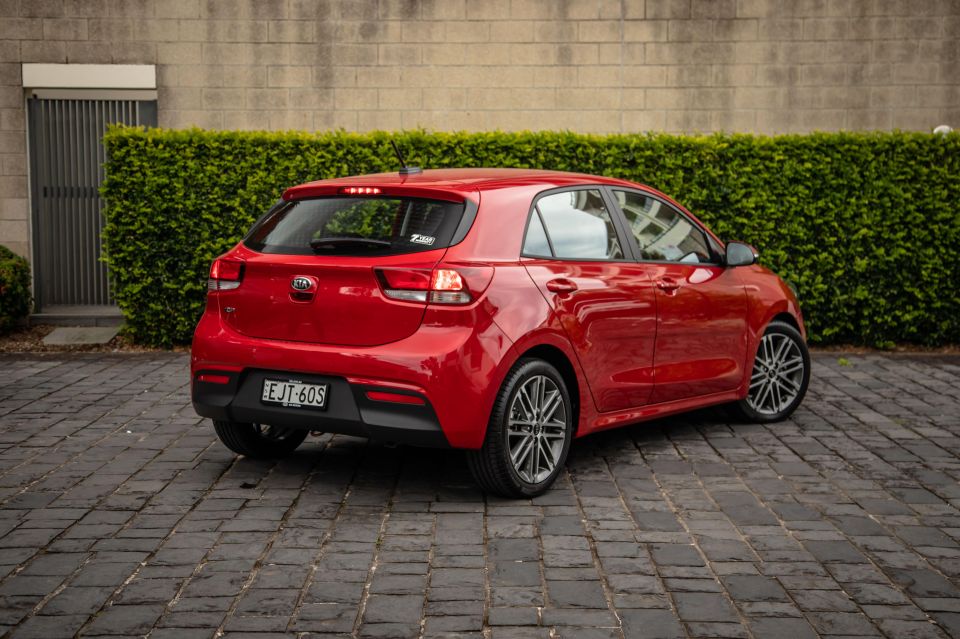

Journalist
New from
$22,890
excl. on-roads

Journalist
New from
$22,890
excl. on-roads


Journalist
New from
$22,890
excl. on-roads

Journalist
New from
$22,890
excl. on-roads
Quickly see how this car stacks up against its competition. Select any benchmark to see more details.
Where expert car reviews meet expert car buying – CarExpert gives you trusted advice, personalised service and real savings on your next new car.
At 51 years young, I can barely remember much about my first car – a 1977 Mazda 323 auto hand-me-down from Mum, other than its suite of safety features can be surmised in ‘horn’ and ‘seatbelts’.
No, I don’t remember the brakes or tyres being very safe at all.
I ought to remember these things when tasked with reviewing the 2021 Rio Sport, Kia’s compact option for a youngster’s first foray on the roads. That’s because, newly for 2021, it’s been updated to include autonomous emergency braking.
At $22,890 before on-road costs (or $23,490 drive-away), the Sport auto isn’t the most affordable Rio in range – that’s the S manual at $19,090 – or the cheapest method of Kia mobility with fitted AEB, an accolade that goes to the Picanto S, at just $15,690 list.
But it’s the step-in point for a proper safety suite inclusive of forward collision and lane-keeping/lane-following smarts, wrapped in a decent-sized, five-star-ANCAP-rated metal box.

That’s right, the base S and new SX grades of Rio omit AEB and lane-keeping smarts.
This pair might be considered viable options affordable ‘other car’ runabouts or grocery-getters for more experienced drivers and there are those who opine today’s youth are too wrapped up in “cotton wool”, but for me and my learner-driver kids – of which I have two – my personal sense of first-car surety begins at Rio Sport.
Collision avoidance as safety is one thing. Collision avoidance as mitigation from outlaying premiums and repair bill from accident damage when you’re on a tight youthful budget is also, for my money, a fair consideration.
How does the rest of the Rio Sport package stack up? Let’s strap on the L-plates and find out.

As mentioned, the 2021 Kia Rio Sport automatic on test clocks in at $22,890 plus on-road costs or $23,490 as a drive-away prospect. The manual version is $1000 more affordable in drive-away pricing.
There’s much choice in the Rio, with four variants and all but the flagship GT-Line available in a choice of auto or manual transmission in a range spread priced between $19,090 (S manual) and $24,990 (GT-Line auto) before on-roads.
Colour choice is Clear White as standard or six other hues, such as our Signal Red test car, fetching $520 extra.
For what’s considered a shrinking end of the market, there’s a lot of choice in the Micro/Light/City/Compact end of the swimming pool if you have a bit of budget flexibility.
Taking Rio Sport’s $23k as a rough cap, there’s competition in rivals such as Honda Jazz VTi-S ($20,990), Mazda 2 G15 Pure ($20,990), MG3 Excite with Nav ($18,990), Skoda Fabia 81TSI ($21,390), Suzuki Swift GL Navigator Plus ($21,490), Toyota Yaris Ascent Sport ($22,130) and Volkswagen Polo 85TSI Comfortline ($20,890).
Or, for a bit of left-field three-door fun, the Fiat 500 Club auto ($23,250).
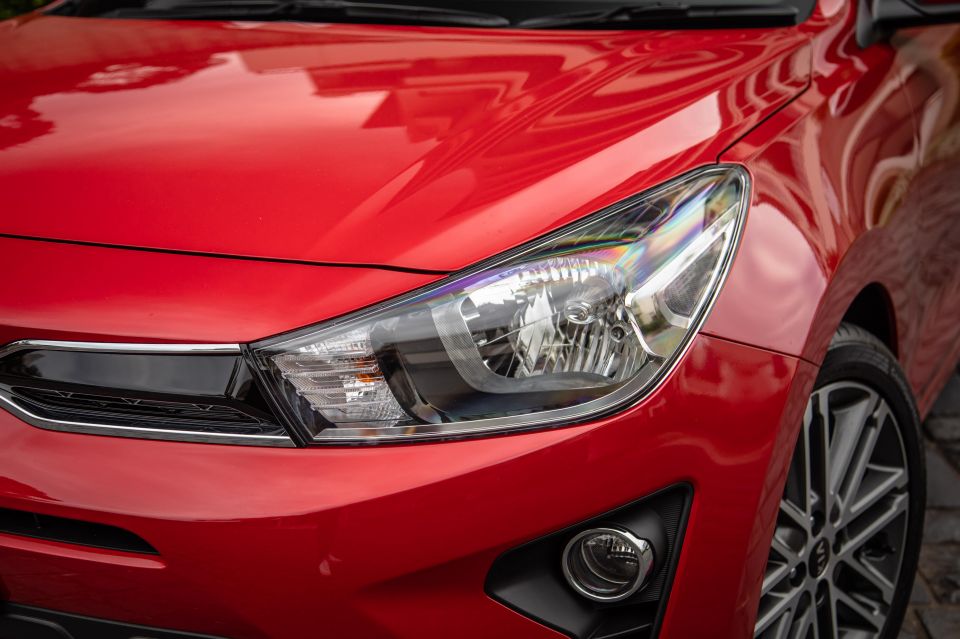
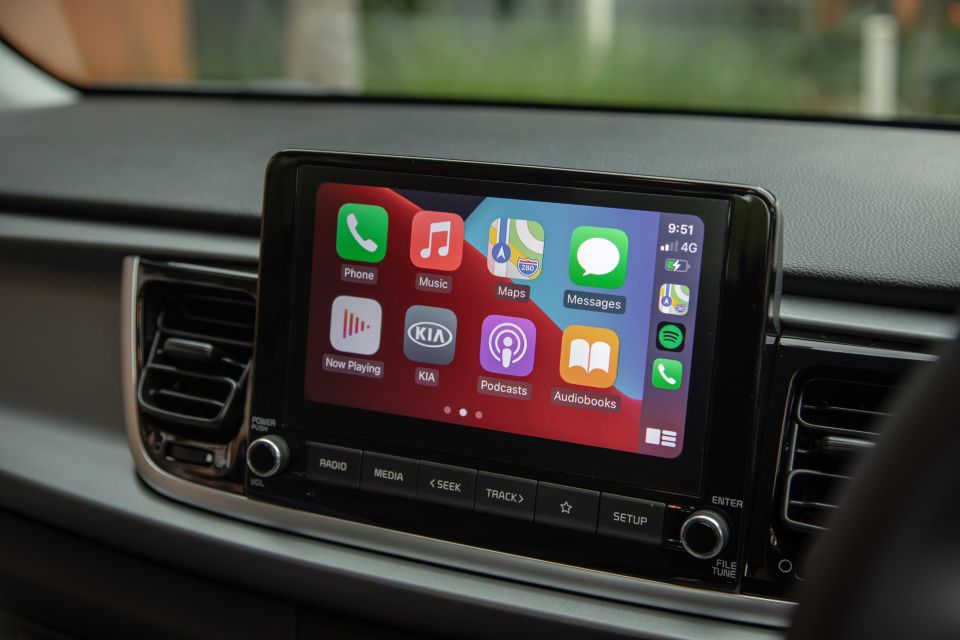
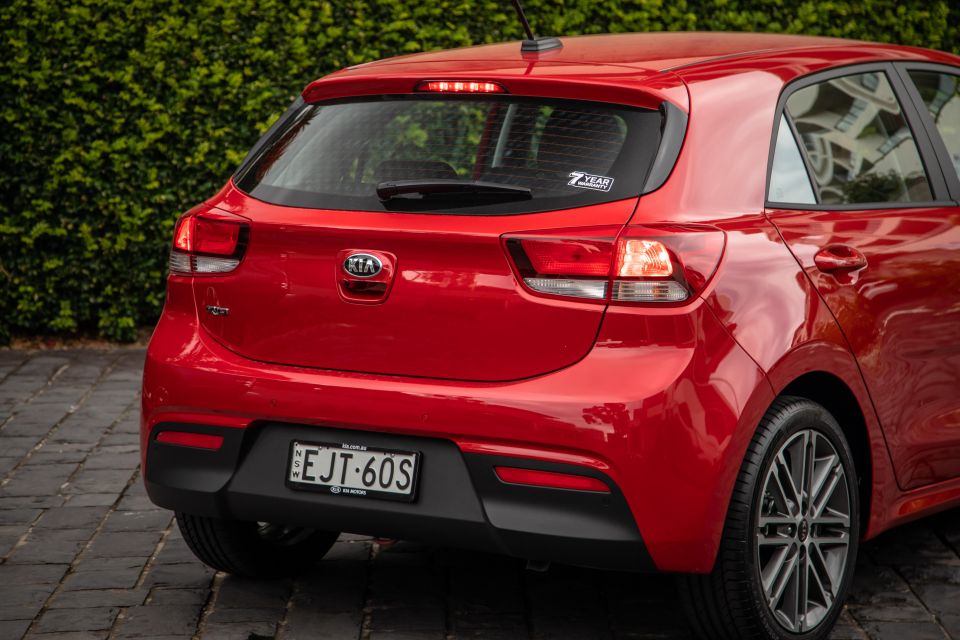
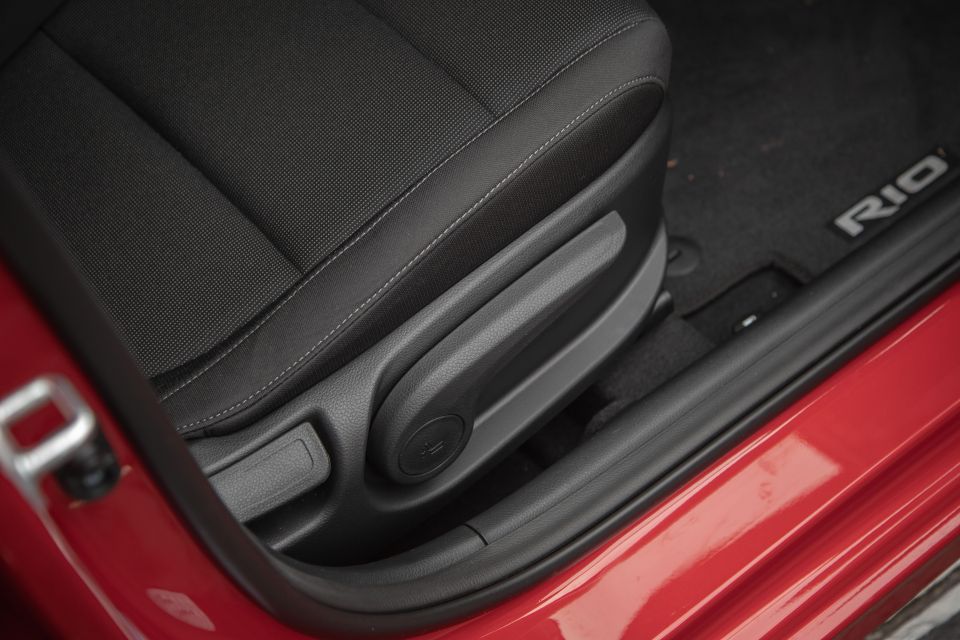
Buy your new car without the stress. It's fast, simple and completely free.

Great service from Travis and team, second time I have used this business would not hesitate to recommend them to anyone
Craig C.
Purchased a Ford Ranger in Sunshine Coast, QLD
CarExpert helped Craig save thousands on his Ford Ranger, now let us save you on your next new car.
Find a dealRio S and Sport models feature automatic halogen headlights, rear parking sensors, a reversing camera with dynamic guidelines, power windows and mirrors, remote central locking, as well as single 12-volt and dual USB-A outlets.
Also across the range is the same 8.0-inch LCD colour touchscreen infotainment system with six-speaker audio, wireless Apple CarPlay/Android Auto and Bluetooth phone and media connectivity.
Question is: what separates the SX and the Sport that wants for $500 more?
Most importantly, there’s the Sport’s fitment of AEB and lane-keeping/lane-following smarts. Outside of that, the pair both fit 17-inch alloys, cruise control, manual air-con, heated and power-folding mirrors as well as high-grade steering and shift knob touch points – labelled ‘premium’ trim, or leatherette to you and I.
The main difference is that the SX has leatherette seat trim, a sunroof, privacy glass and illuminated vanity mirrors in trade for the absence of the cloth-trimmed Sport’s safety tech.
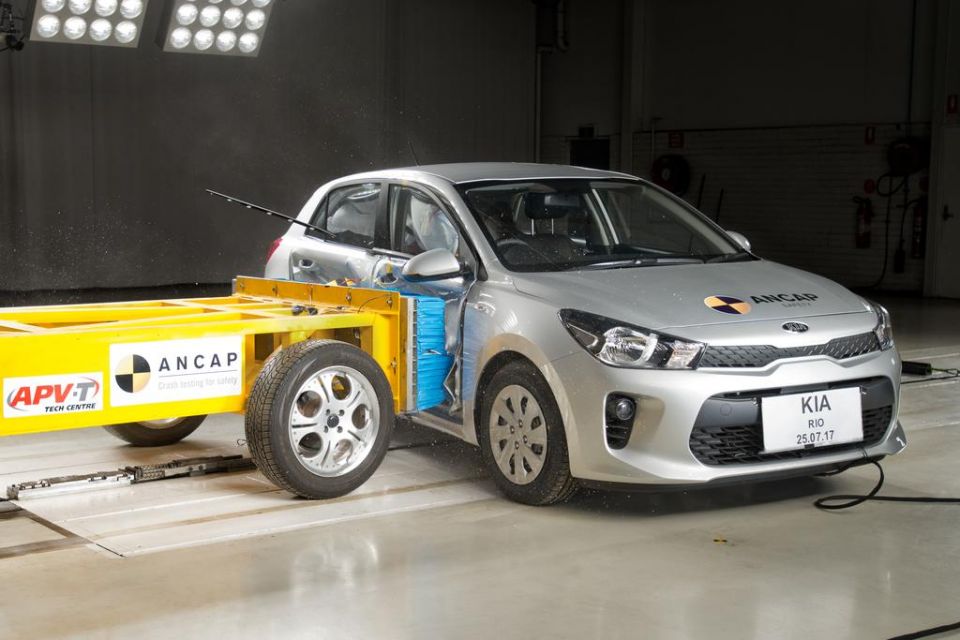
The Rio range scored a full five stars in ANCAP assessment conducted in 2017.
Under an older scoring system, this result was based on 14.52 out of 16 for frontal offset crash testing and an excellent 16 out of 16 for side impact integrity. Whiplash and pedestrian protection were deemed Good and Acceptable, respectively.
The Sport gets six airbags, four-wheel disc brakes, autonomous emergency braking, forward collision alert, lane-keep assist, Lane Following Assist (lane centring), lead vehicle departure warning and driver attention monitoring.
The rear seating features ISOFIX mounts and three positions of child restraint anchor points. Hill-start assist is also standard.
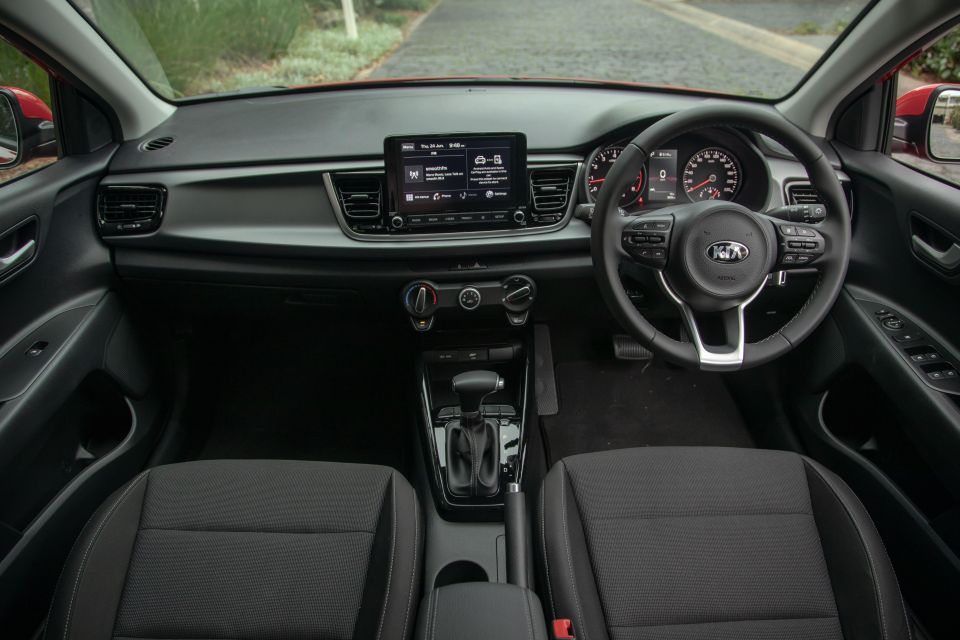
The cabin of the Sport presents quite nicely for its price, with typically Kia styling that includes a slew of nifty design tricks to make the most of a cost-conscious environment.
Specifically, much of the cabin is finished in particularly dark grey with satin grey and gloss black detailing and highlights, cookie-cut from elsewhere in the Korean marque’s stable and used to good effect here.
The general ambience is decent. It feels sporty enough to suit its name, and the combination of the conspicuous 8.0-inch touchscreen, 4.2-inch colour driver’s screen (with digital speedo), and premium-grade multi-function steering wheel and transmission selector making for ample feel-good, upmarket vibes.

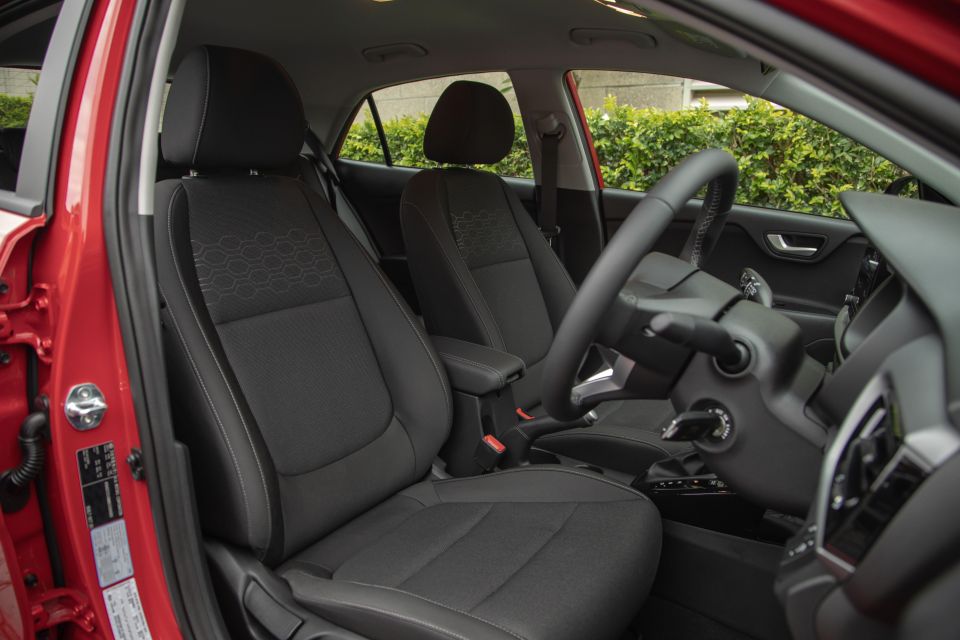
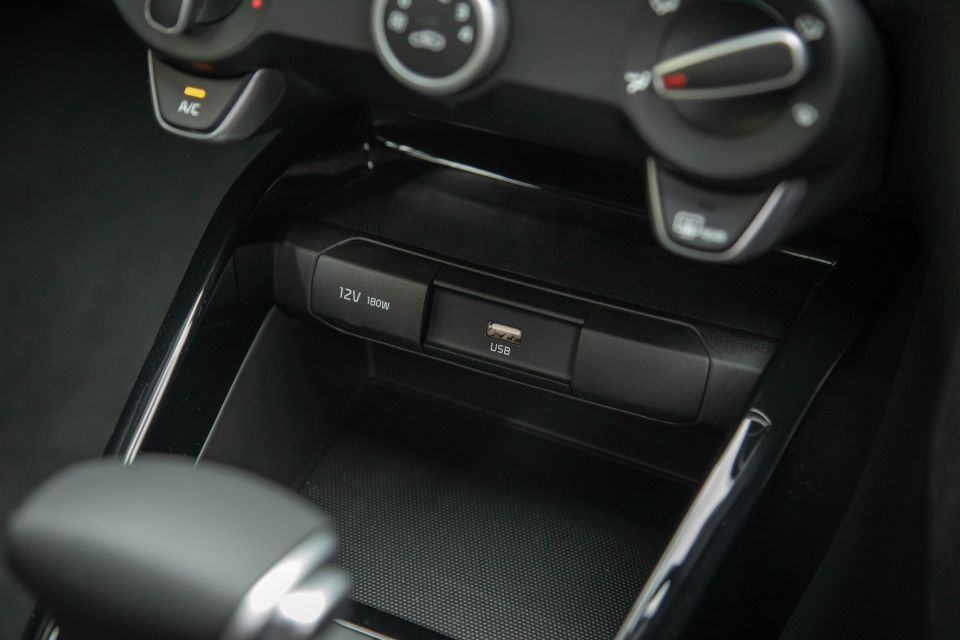

The key-barrel ignition and acres of hard plastic on the door trims betray its humble means, but there’s nothing too cheap feeling nor flimsy.
Indeed, Kia does a beaut job with quality switchgear and buttons, particularly those on the steering wheel, and as general impressions go the Sport punches a little above its form guide in the flesh. The manual air-con is hardly the last word in sophistication but it’s quiet enough and does the job.
The six-way driver’s seat allows tailor fitment for what’s a fairly low-slung and sporty seating position, though outward visibility is clear and generous. The seats themselves are fine enough, with pliant cushioning and a fair amount of bolstering for lateral body support. Event the so-called Tricot trim is nicely textured and not too scratchy to touch.
Infotainment-wise, the 8.0-inch format looks the biz but is a bit of a blank canvas bar rudimentary AM/FM radio functionality and a decent reversing camera system that’s impressively large and clear for the sort of money this Kia wants for.
On test, the CarPlay mirroring functioned consistently enough both wired and wirelessly, allowing the smartphone to do the connectivity heavy lifting.
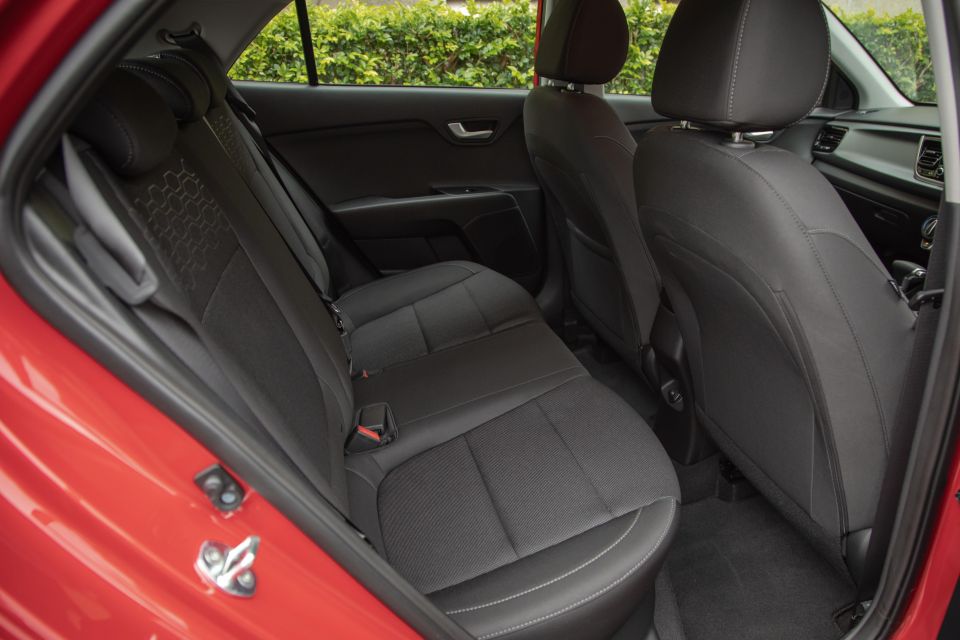
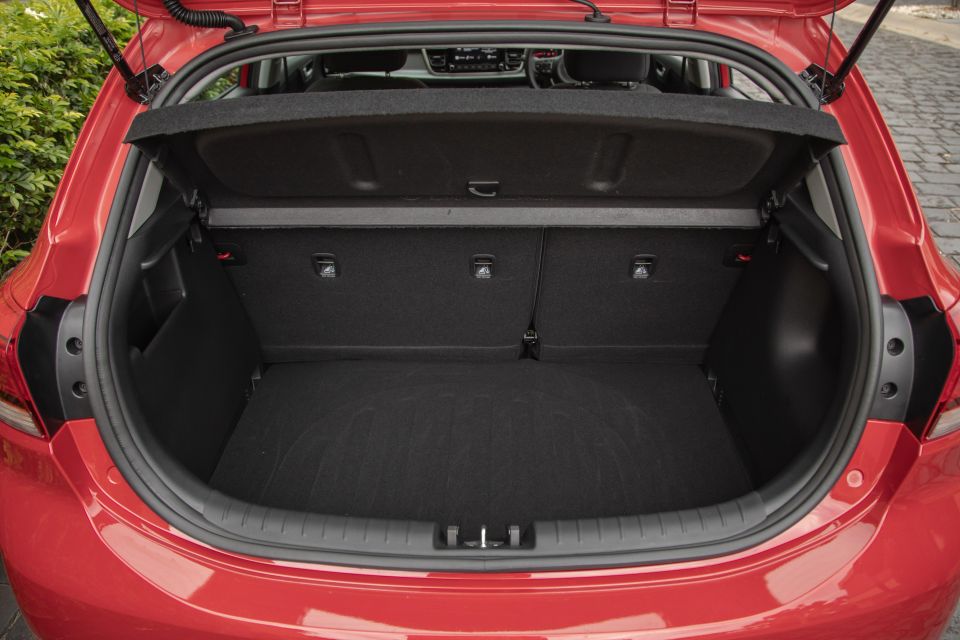


Row two mirrors the front in look and styling, but accommodation-wise it’s a bit of a tight fit your author’s 180-centimetre frame. It’ll haul four adults, just not with much long-hauling comfort. There’s a sole USB power for device power but, unfortunately, no rear air vents.
Boot space is useable 325 litres of neatly square proportions and deep floor, which lifts to reveal a space saver spare. Drop the 60:40 split-fold rear seat backs reveals a total advertised volume of 980 litres.
All in all, it’s a well-formed and functional cabin space that avoids feeling too economical that’s ‘beginner friendly’ with (just) enough room for youngsters to share with friends.

Let’s face it, nobody will be rushing to Instagram to brag to their mates about the 74kW and 133Nm produced by the Sport’s 1.4 litres of four-cylinder natural aspiration.
And, if this review was to focus more on finding a cheap fun machine, the recommendation would be to save some extra coin and stump up for the equally powerful if torquier (172Nm) 1.0-litre turbo three-pot in the flagship GT-Line.
But sticking with a ‘Your First Car’ theme, the modestly-powered four is mostly not such a bad thing for the beginner driver. Most newcomers to motoring will inevitably opt for the six-speed conventional auto as tested here though, as mentioned above, there’s a six-speed manual available if you desire.
It runs on regular 91 RON fuel in its modest 45-litre tank, which is handy, and is advertised as having a thrifty 6.0L/100km combined fuel consumption.
During our mostly urban testing the little Kia didn’t get much near that, instead hovering up into the nines and occasionally dipping into double figures, for fairly logical real-world reasons.
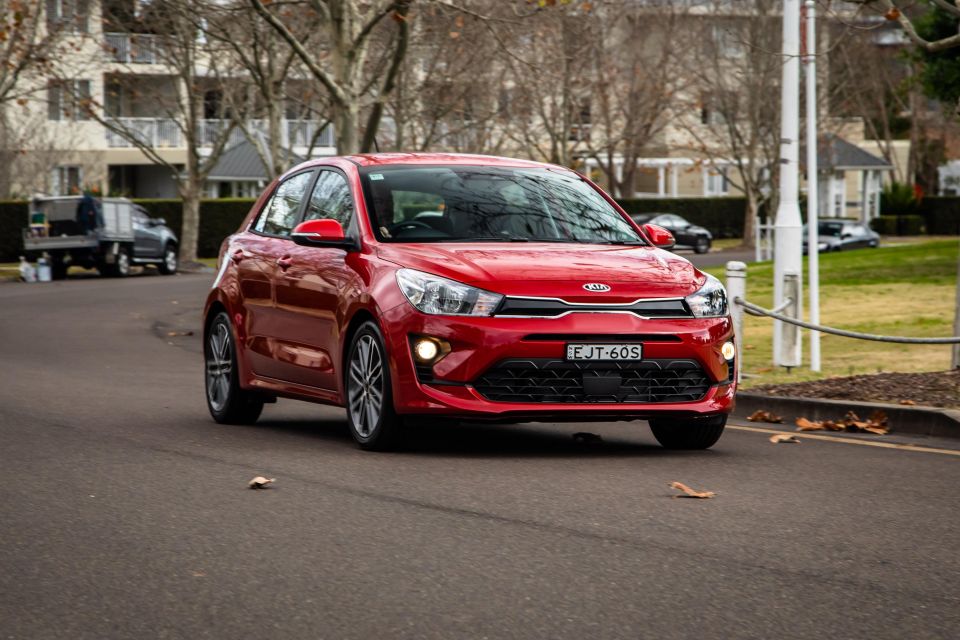
At 1132kg tare, there’s no much of the Rio Sport to push around. And yet the little 1.4-litre four is almost always working fairly hard for its keep because it has to.
Not just overtaking or lunging out from a side street into traffic, where either quest demands deft judgment and a fair amount of patience, but also with general go-with-the-flow traffic movement.
It’s not terribly urgent off the mark and there’s a fair absence of enthusiasm to accelerate with much vigour through the engine’s mid-range as peak torque, what little it has, doesn’t arrive until 4000rpm. It’s less of a race and more of leisurely stroll, then, to the 6000rpm redline.
This isn’t (mostly) such a bad thing for a beginner. Pinning the throttle to the floor does result in not unreasonable acceleration, if complimented by a fair amount of unrewarding racket from under the bonnet and an auto that’s a little tardy to shift ratios when it needs to.
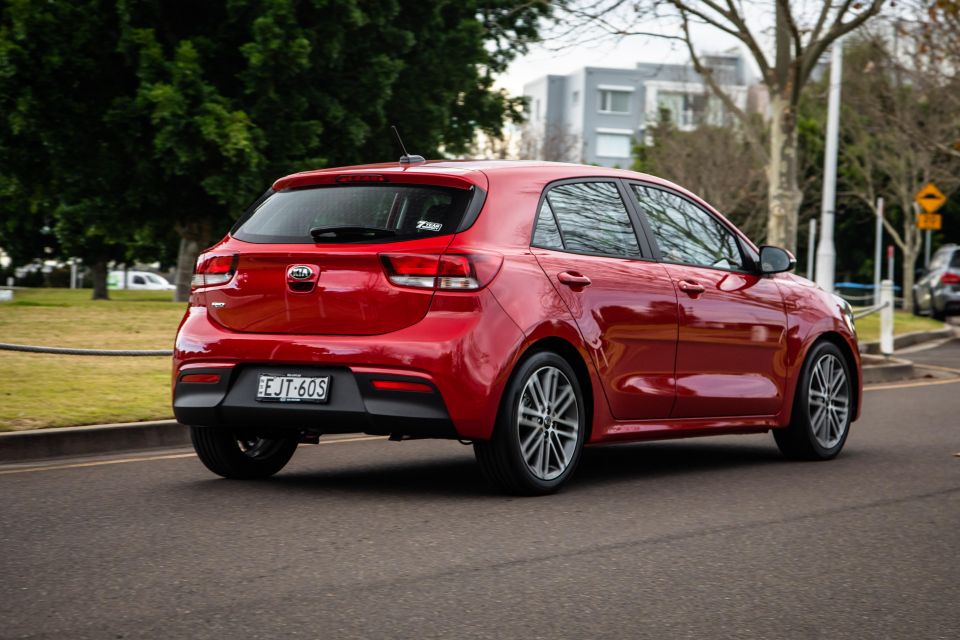
In short, it’s the sort of restraint I’d want my kids learning in. Provided, that is, it instills patience into driving habits that I hope it might. The downside, however, is you risk getting caught a little short on power/torque as a method of getting out of harm’s way in an emergency.
Another byproduct of the modest torque count is that the more occupants you load aboard the more that the Sport’s lethargy is compounded. That’s perhaps not such a bad thing when it comes to provisional licence holders.
The rest of the on-road Rio Sport experience is… fine enough. It’s small – just over four metres long – offers a tight 10.2m turning circle, and is easy to place and judge on the road. A cinch to park too. But as a polished drive it does lack a bit in a few areas.
The steering is little heavier than is necessary and the lane-keeping assistance, self-activating as low as 50km/h, is overbearing if thankfully easy to switch off. Whether such aggressive steering correction is strictly necessary, let alone downright confronting during the process of getting a handle on the youthful practice of driving itself, is something I’m willing to debate.
The suspension does feel like it skipped finishing school. The ride is firm, which isn’t such a drama, but the front axle is prone to a lot of disconcerting noises and clunks, while the combination of taut damping and low-profile rubber conspires to far too much road surface acne transmitting through the cabin and controls.
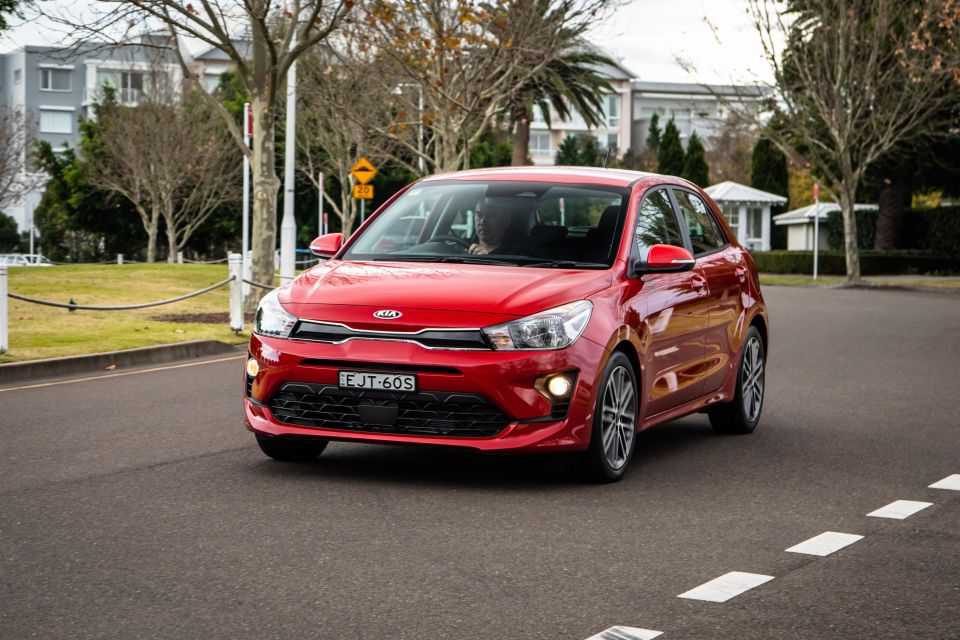
There could be a spirited dynamic character tucked away on its strut and torsion beam suspenders, though there’s not nearly enough enthusiasm with the powertrain to entice you want to explore it. No big criticism, though, for where this little hatchback is pitched.
Its proper competency is more as an all-rounder and, a fair bit of road noise apart, the Rio is decent place to spend long seat time out on the open road, where its lane-keeping smarts start to make a lot more practical sense.
The brakes, though, are excellent: immediate and powerful while offering deft precision through the left pedal that’s not overly assisted. Indeed, the Rio fits both brake assist and electronic brake force distribution for its 256mm front/262mm rear disc combination, and the feel of the system’s calibration is well executed.
All up, a solid enough performance on road, if with areas where it could do with some improvement.
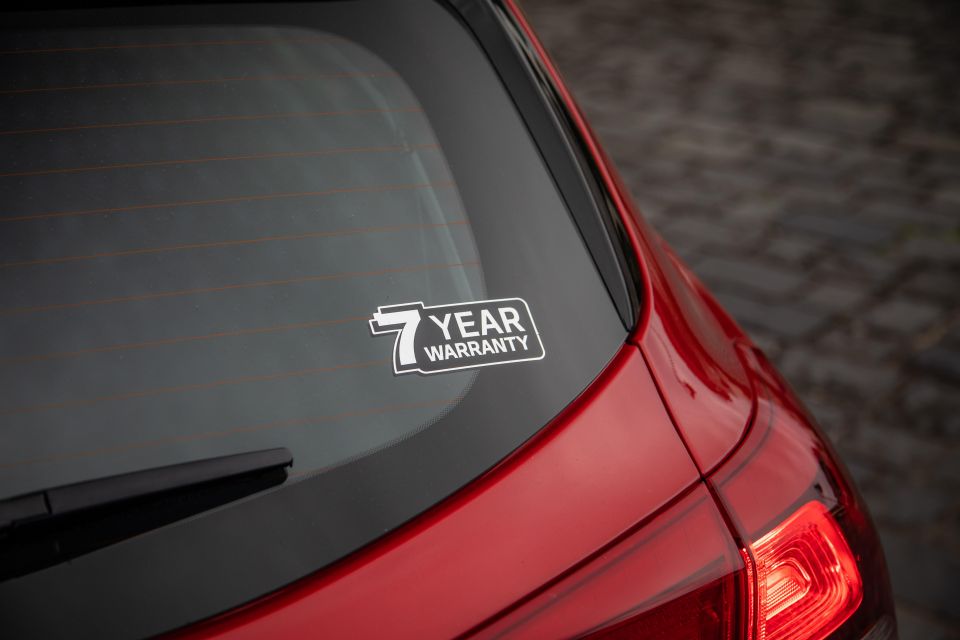
The Rio Sport is covered by Kia’s excellent seven-year, unlimited-kilometre warranty with seven years of capped-price servicing and roadside assistance.
Servicing intervals are 12 months or 15,000km, whichever comes first.
These are capped between $269 and $689 across the first seven visits for what’s an average of $421 per year. Not cheap then.

Where expert car reviews meet expert car buying – CarExpert gives you trusted advice, personalised service and real savings on your next new car.
Does the Rio Sport make for a decent first car? It presents well, has decent feel-good factor for the money and backs up a workmanlike driving experience with the sort of safety blanket you’d hope to wrap young loved ones in.
It’s enticing to buy if a little pricey to own, and there’s good chance motoring newcomers will outgrow its modest motivation well before the Rio Sport runs out of warranty. But that’s not a reason to avoid it if the primary role is as a device with which the inexperienced can learn their driving chops.
It’s a decent enough machine to fulfil that role nicely, now it offers the active safety smarts lacking prior to the MY21 update.
But if you’re looking for a third car and cheap and cheerful runabout, it might be worth splurging a few extra grand to swing into the turbocharged GT-Line.
It offers a lot of the same stuff, some extra niceties, and that most torque kick from its DCT-equipped powertrain that is sure to pull some of the frustration out of the Sport’s main shortcomings.
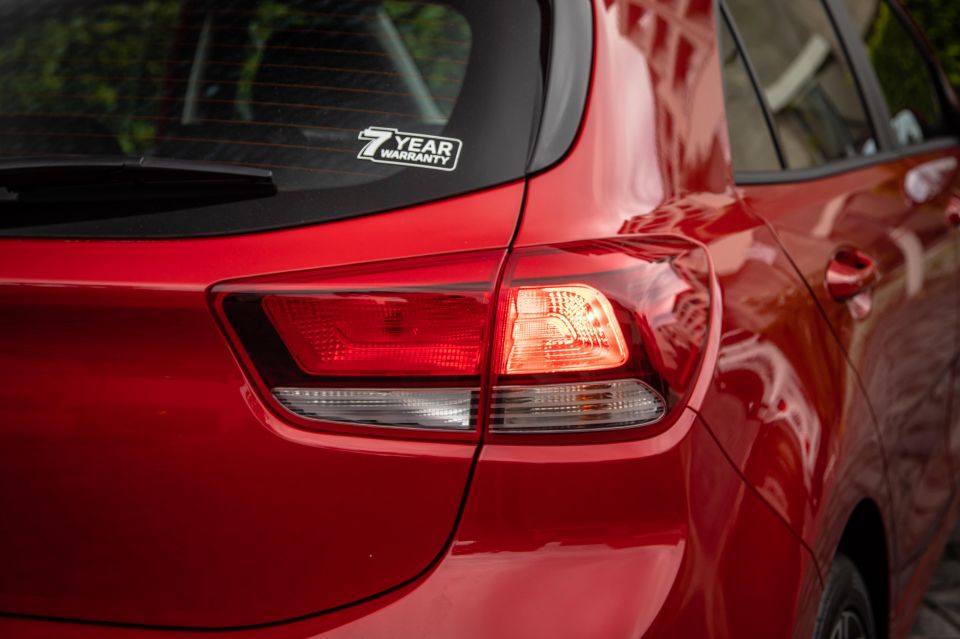
Click the images for the full gallery
Where expert car reviews meet expert car buying – CarExpert gives you trusted advice, personalised service and real savings on your next new car.


Matt Campbell
8 Hours Ago


Max Davies
24 Hours Ago


William Stopford
24 Hours Ago


Derek Fung
1 Day Ago


Max Davies
1 Day Ago


William Stopford
2 Days Ago